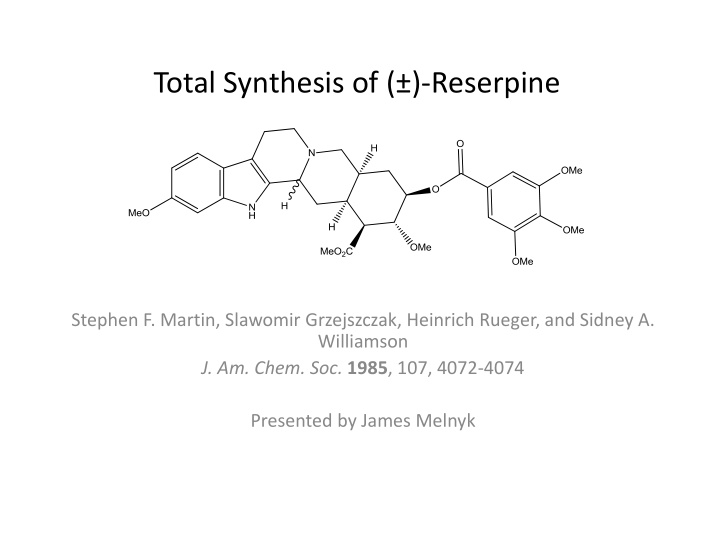



Total Synthesis of (±)-Reserpine Stephen F. Martin, Slawomir Grzejszczak, Heinrich Rueger, and Sidney A. Williamson J. Am. Chem. Soc. 1985 , 107, 4072-4074 Presented by James Melnyk
Stephen F. Martin • A New Mexico native • 1968: B.S. University of New Mexico • 1972: Ph.D. Princeton University – Advisor: Edward C. Taylor • 1972-73: Postdoctoral research – University of Munich – Advisor: Rudolf Gompper • 1973-1974: Massachusetts Institute of Technology, NIH Postdoctoral Fellow – Advisor: George Buchi • 1974: Joined the University of Texas Faculty • M. June and J. Virgil Waggoner Regents Chair in Chemistry • Research focuses on the development and application of new synthetic strategies to the syntheses of natural products
Reserpine • Indole alkaloid first isolated from the Indian snake root, Rauwolfia serpentina, in 1952 • Molecular structure elucidated in 1953 and natural structure published in 1955 • Medicinal agent – antipsychotic and antihypertensive properties • Irreversibly blocks the vesicular monoamine transport (VMAT) protein thus preventing movement of free serotonin, norepinephrine, and dopamine to the storage vesicles for release into the synaptic cleft • Replenishing VMAT levels can take up to weeks thus causing Reserpine to have a long lasting effect • Used sparingly today due to a number of undesirable side effects
Structure of Reserpine
Retrosynthetic Analysis • Synthetic challenge of reserpine is posed by the D/E ring system of the pentacylic nucleus • Synthetic strategy necessitated the preparation of a functionalized hydroisoquinoline derivative that could then be modified to provide the D/E ring system
Prior Work – Diels-Alder Reaction • Preparation of a substituted hydroisoquinoline system was made possible due to previously developed methodology featuring an intramolecular Diels-Alder Reaction using aza-trienes • Transformation occurs by thermolysis at 300 °C in a sealed container Stephen F. Martin, Sidney A. Williamson, R. P. Gist, and Karl M. Smith, J. Org. Chem., 1983 , 48, 5170-5180
(±)-Reserpine Total Synthesis – Part 1
(±)-Reserpine Total Synthesis – Part 2
(±)-Reserpine Total Synthesis – Part 3
(±)-Reserpine Total Synthesis – Part 4
(±)-Reserpine Total Synthesis – Part 5
Conclusion • Novel synthesis of (±)-Reserpine completed in 15 steps featuring use of an intramolecular Diels-Alder cycloaddition for the construction of the functionalized hydroisoquinoline • Individual steps were generally moderate to high yielding • General synthetic strategy has potential for the synthesis of other alkaloid natural products
Recommend
More recommend